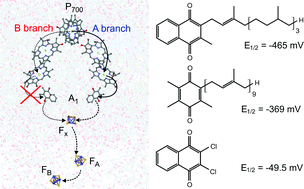Photosystem I (PS I) has two nearly identical branches of electron-transfer co-factors. Based on point mutation studies, there is general agreement that both branches are active at ambient temperature but that the majority of electron-transfer events occur in the A-branch. At low temperature, reversible electron transfer between P700 and A1A occurs in the A-branch. However, it has been postulated that irreversible electron transfer from P700 through A1B to the terminal iron-sulfur clusters FA and FB occurs via the B-branch. Thus, to study the directionality of electron transfer at low temperature, electron transfer to the iron-sulfur clusters must be blocked. Because the geometries of the donor–acceptor radical pairs formed by electron transfer in the A- and B-branch differ, they have different spin-polarized EPR spectra and echo-modulation decay curves. Hence, time-resolved, multiple-frequency EPR spectroscopy, both in the direct-detection and pulse mode, can be used to probe the use of the two branches if electron transfer to the iron-sulfur clusters is blocked. Here, we use the PS I variant from the menB deletion mutant strain of Synechocyctis sp. PCC 6803, which is unable to synthesize phylloquinone, to incorporate 2,3-dichloro-1,4-naphthoquinone (Cl2NQ) into the A1A and A1B binding sites. The reduction midpoint potential of Cl2NQ is approximately 400 mV more positive than that of phylloquinone and is unable to transfer electrons to the iron-sulfur clusters. In contrast to previous studies, in which the iron-sulfur clusters were chemically reduced and/or point mutations were used to prevent electron transfer past the quinones, we find no evidence for radical-pair formation in the B-branch. The implications of this result for the directionality of electron transfer in PS I are discussed.


 Please wait while we load your content...
Please wait while we load your content...